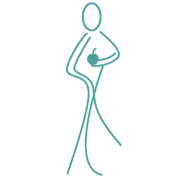The aging process impacts on the structure and function of connective tissues. As we become older changes occur within our muscles, tendons and bones. Muscles lose their mass and elasticity. Strength decreases, most noticeably handgrip strength making it difficult to perform activities of daily living such as opening jars. The water content of tendons decreases causing increased stiffness and less capability to withstand stress, increasing the risk of injury. Ligaments loss elasticity causing reduced flexibility. This may give rise to early morning stiffness, low back pain, neck and upper and lower limb pain. Loss of balance frequently occurs within the aging population.
During the aging process bones become more fragile due to the loss of mineral content. Osteoporosis may occur, osteoporosis contributes to a high percentage of hip fractures in the elderly. Degeneration of the cartilage occurs, which results in less cushioning between the bones and may contribute to arthritic conditions.
The metabolic rate slows which can lead to weight gain, increasing the stress on the heart and joints. The heart becomes less able to propel blood quickly around the body thus we become fatigued and the healing rate slows down.
Ok so that is the bad news but what, if anything can be done to help? Actually there is a lot that can be done. Exercise and activity becomes more important as we age. Walking, swimming, Tai Chi or just keeping mobile helps to slow down many of the negative effects associated with ageing in the body. In addition, keeping active helps to maintain brain capacity, it’s a fact!
Osteopathic treatment is designed to alleviate pain and injury and to help prevent reoccurrences. Osteopathy can help to reduce pain and stiffness therefore reducing the reliance on pain relief and anti-inflammatory medication
Osteopaths recognise the interrelationship of structure and function within the body. They can provide stretching programmes to help maintain joint flexibility. Massage helps to decrease swelling as well as increasing the blood flow thus increasing the healing rate. The use of joint mobilisation and manipulation in conjunction with massage helps to relieve muscle tension and increase joint mobility.
Postural advice and exercise programs to improve strength and balance can be provided by osteopaths, to help keep you mobile. Although osteopathy cannot cure some conditions related to ageing, for example arthritic conditions, it can help to keep patients moving and reduce the potential for more invasive interventions, such as surgery.
We often hear in clinic from our older patients that their problem is probably just due to ‘old age’ but often this is not the case. The interventions that are highlighted in this article, whether self directed or with the help of an osteopath can have a dramatic effect by reducing pain and improving quality of life. The old saying is often true ‘you are only as old as you feel.
Jenny Mullen
Registered Osteopath
The Osteopathic Centre Pte Ltd
 Psychology
Psychology Osteopathy
Osteopathy Diet & Nutrition
Diet & Nutrition